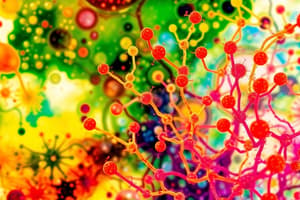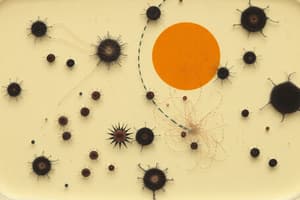Podcast
Questions and Answers
What is the purpose of using a mordant in the Gram staining procedure?
What is the purpose of using a mordant in the Gram staining procedure?
- To wash away excess stain
- To enhance the binding of the primary stain (correct)
- To provide a contrasting color
- To stain the bacterial cells
Which of the following steps follows the application of crystal violet in the Gram staining process?
Which of the following steps follows the application of crystal violet in the Gram staining process?
- Pour off the crystal violet stain and wash (correct)
- Heat-fix the smear
- Flood the slide with decolorizer
- Flood the slide with counter stain
At what temperature should the Petri dish be incubated for bacterial culture?
At what temperature should the Petri dish be incubated for bacterial culture?
- 30 °C
- 25 °C
- 37 °C (correct)
- 42 °C
What is the first step in preparing a slide for Gram staining?
What is the first step in preparing a slide for Gram staining?
What is an important consideration when heat-fixing a smear?
What is an important consideration when heat-fixing a smear?
Which reagent in the Gram staining process acts as a decolorizer?
Which reagent in the Gram staining process acts as a decolorizer?
When observing a stained smear under a microscope, which objective lens should oil be used with?
When observing a stained smear under a microscope, which objective lens should oil be used with?
What is the benefit of using an inverted position for incubating the Petri dish?
What is the benefit of using an inverted position for incubating the Petri dish?
In identify bacterial cultures, which of the following describes Staphylococcus aureus?
In identify bacterial cultures, which of the following describes Staphylococcus aureus?
What is the purpose of counterstaining in the Gram stain method?
What is the purpose of counterstaining in the Gram stain method?
What is the primary purpose of the streak plating technique?
What is the primary purpose of the streak plating technique?
Which type of bacteria retains the crystal violet stain during the Gram staining procedure?
Which type of bacteria retains the crystal violet stain during the Gram staining procedure?
What are Colony Forming Units (CFU) used to quantify?
What are Colony Forming Units (CFU) used to quantify?
What is the first step in the Gram staining procedure?
What is the first step in the Gram staining procedure?
What is the primary purpose of the streaking method?
What is the primary purpose of the streaking method?
What does the term 'pure culture' imply?
What does the term 'pure culture' imply?
Which of the following media is NOT typically used for isolating bacterial organisms?
Which of the following media is NOT typically used for isolating bacterial organisms?
Which of the following techniques involves using a glass spreader?
Which of the following techniques involves using a glass spreader?
During microscopy, which characteristic helps differentiate between Gram-positive and Gram-negative bacteria?
During microscopy, which characteristic helps differentiate between Gram-positive and Gram-negative bacteria?
What should be avoided when performing an isolation streak plate?
What should be avoided when performing an isolation streak plate?
Which staining technique allows for the visualization of specific cellular structures?
Which staining technique allows for the visualization of specific cellular structures?
What precaution should be taken while processing samples in a microbiology lab?
What precaution should be taken while processing samples in a microbiology lab?
What technique is used to quantify bacterial colonies after the spread plating method?
What technique is used to quantify bacterial colonies after the spread plating method?
What is the result of a perfect spread plate technique?
What is the result of a perfect spread plate technique?
What structural feature differentiates Gram-negative bacteria from Gram-positive bacteria?
What structural feature differentiates Gram-negative bacteria from Gram-positive bacteria?
Which type of staining uses dyes that stain only the background?
Which type of staining uses dyes that stain only the background?
What is a key characteristic of Gram-positive bacteria?
What is a key characteristic of Gram-positive bacteria?
What is the best position for incubating agar plates?
What is the best position for incubating agar plates?
Which of the following is true about indirect staining?
Which of the following is true about indirect staining?
What role does microscopy play in microbiology?
What role does microscopy play in microbiology?
What is the primary purpose of Gram staining?
What is the primary purpose of Gram staining?
Which type of bacterial cell wall retains the crystal violet-iodine complex during Gram staining?
Which type of bacterial cell wall retains the crystal violet-iodine complex during Gram staining?
What color do Gram-negative bacteria appear after the Gram staining procedure?
What color do Gram-negative bacteria appear after the Gram staining procedure?
In the streak plating technique, what is the purpose of sterilizing the inoculation loop after streaking?
In the streak plating technique, what is the purpose of sterilizing the inoculation loop after streaking?
How should the Petri dish be manipulated during the streak plating technique?
How should the Petri dish be manipulated during the streak plating technique?
What type of agar plates were used in the isolation of pure cultures in the practical case?
What type of agar plates were used in the isolation of pure cultures in the practical case?
Which of the following best describes the staining property of Gram-positive organisms?
Which of the following best describes the staining property of Gram-positive organisms?
What is the composition of the crystal violet-iodine complex during Gram staining?
What is the composition of the crystal violet-iodine complex during Gram staining?
At what temperature and conditions is incubation typically done for the culture of bacteria in this method?
At what temperature and conditions is incubation typically done for the culture of bacteria in this method?
Which microscopy technique can be used to observe stained bacterial cultures?
Which microscopy technique can be used to observe stained bacterial cultures?
Flashcards
Pure Culture
Pure Culture
A culture containing only one type of bacteria.
Isolation Technique
Isolation Technique
Methods used to separate one type of bacteria from a mixed culture.
Streak Plate
Streak Plate
A technique to isolate bacteria by spreading a sample across an agar plate.
Streaking
Streaking
Signup and view all the flashcards
Agar Plate
Agar Plate
Signup and view all the flashcards
Colony-Forming Unit (CFU)
Colony-Forming Unit (CFU)
Signup and view all the flashcards
Mixed Culture
Mixed Culture
Signup and view all the flashcards
Inoculation loop
Inoculation loop
Signup and view all the flashcards
Microorganism
Microorganism
Signup and view all the flashcards
Culture
Culture
Signup and view all the flashcards
Gram Staining
Gram Staining
Signup and view all the flashcards
Gram-positive bacteria
Gram-positive bacteria
Signup and view all the flashcards
Gram-negative bacteria
Gram-negative bacteria
Signup and view all the flashcards
Peptidoglycan
Peptidoglycan
Signup and view all the flashcards
Crystal Violet
Crystal Violet
Signup and view all the flashcards
Counterstain
Counterstain
Signup and view all the flashcards
Pure Culture Isolation
Pure Culture Isolation
Signup and view all the flashcards
Blood Agar Plate
Blood Agar Plate
Signup and view all the flashcards
MacConkey Agar
MacConkey Agar
Signup and view all the flashcards
Streaking Method
Streaking Method
Signup and view all the flashcards
Streak plate method
Streak plate method
Signup and view all the flashcards
Mixed/Contaminated Culture
Mixed/Contaminated Culture
Signup and view all the flashcards
Viable Culture
Viable Culture
Signup and view all the flashcards
Direct Staining
Direct Staining
Signup and view all the flashcards
Indirect/Negative Staining
Indirect/Negative Staining
Signup and view all the flashcards
Selective Staining
Selective Staining
Signup and view all the flashcards
Differential Staining
Differential Staining
Signup and view all the flashcards
Spread Plate Technique
Spread Plate Technique
Signup and view all the flashcards
Microbial Staining
Microbial Staining
Signup and view all the flashcards
Primary Stain
Primary Stain
Signup and view all the flashcards
Mordant
Mordant
Signup and view all the flashcards
Decolorizer
Decolorizer
Signup and view all the flashcards
Heat-Fixing
Heat-Fixing
Signup and view all the flashcards
Smear Preparation
Smear Preparation
Signup and view all the flashcards
Microscope Observation
Microscope Observation
Signup and view all the flashcards
Study Notes
Basic Microbiology - Practical No. 4: Isolation of Pure Culture and Gram Staining
- Intended Learning Objectives (ILOs):
- Define pure culture and methods for obtaining it
- Explain the purpose of different isolation techniques
- Demonstrate the isolation streak plate procedure
- Prepare bacterial smears and perform Gram stain
- Explain the staining technique's chemical basis and principle
- Differentiate Gram-positive and Gram-negative bacteria using a light microscope
- Describe the differences in cell wall structures of Gram-positive and Gram-negative cells
- Understand the use of different media for isolating various bacterial organisms
Precautions
- Wear appropriate personal protective equipment (PPE)
- Adhere to Standard Operating Procedures (SOPs) for sample processing
- Immediately record results
Introduction/Background
- Culture: Cultivating microorganisms in a lab for study
- Crucial to ensure samples are pure cultures (single type of bacteria) or not mixed
- Mixed cultures often come from non-sterile sources
Methods of Isolation of Pure Culture
- Streak plating: Using a sterile inoculation loop to spread a sample across an agar plate
- Spread plating: Using a glass spreader to spread a liquid sample evenly on an agar plate
- Pour plating: Mixing diluted samples with melted agar, then pouring into sterile plates
Streak Plate Technique
- Technique isolates individual bacterial colonies (CFU) on an agar plate using a wire loop
- Aims to: differentiate pure and mixed cultures; identify viable cultures
Spread Plate Technique
- Technique where a sample is placed on a plate, then spread evenly using a spreader
- Ensure even and visible colonies
Microbiological Staining
- Microbial cells are too small to see without a microscope
- Staining enhances visibility by giving them colour
- Direct staining: using aniline dyes to stain bacterial cells directly. Exceptions include bacterial spores and those with a waxy coating
- Indirect/Negative staining: Staining the background to visualize bacteria/structures
Gram Staining
- Developed by Hans Christian Gram (1853–1938)
- Differentiates bacteria as Gram-positive or Gram-negative based on cell wall composition
- Purpose: Differentiate Gram-positive and Gram-negative organisms, and learn about their cellular morphology & arrangements
- Principle: Gram-positive cells retain crystal violet-iodine complex; Gram-negative cells decolorize, allowing a counter stain (safranin) to bind
- Gram-positive cells appear blue/purple; Gram-negative appear pink/red
Preparation & Staining Steps (Detailed in separate pages 7-8)
- Preparing bacterial smears
- Applying specific stains
- Avoiding excessive heat during heat fixation
- Using various solutions: Crystal violet, Gram's iodine, alcohol decolorizer and counter stain like safranin
Observation
- Record Gram reactions, shapes and arrangements for observed samples (e.g., samples A and B)
Studying That Suits You
Use AI to generate personalized quizzes and flashcards to suit your learning preferences.




